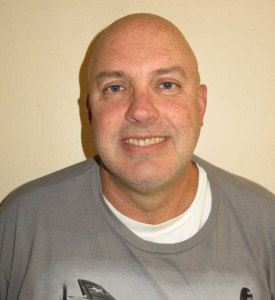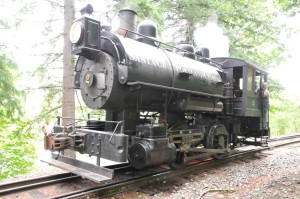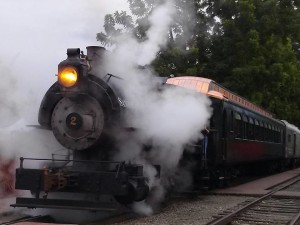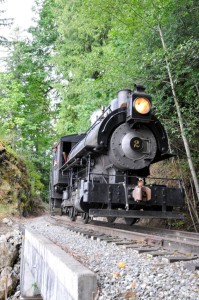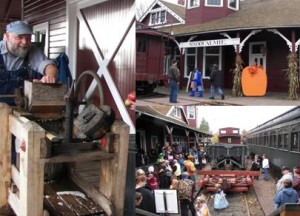Al Frasch / Photos by Jon Wilbert
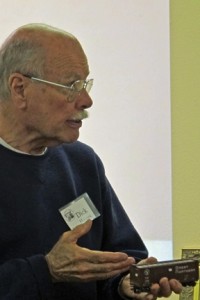
Dick Haines showing boxcar with installed sound decoder
Wednesday, October 8th, 2014 saw twenty-two interested model railroaders in attendance at the annual “Mini-clinics” session. Rich Blake welcomed everyone to the evening’s action which began with Dick Haines showing the new Sound Car decoder from Bachmann. He explained his installation in a boxcar with decoder, speaker and a “keep alive.” He indicated the price was in the mid-$30 range and requires a speaker of your choice. He suggested that one could add such a car every 3 or 4 cars to realistically portray the wheel click and squeal of the prototype.
The first Mini-clinic was a four part talk by John White titled “Flat Cars.” John models in On30, but the principles should hold for all scales except maybe for zed (Z scale). Part 1 was on giving the flat cars weight. He uses small lead shot to arrive at about 4 ounces, gluing them to the under structure using white glue to fully encase the shot. Then a coat of grimy black hides them quite well.
Part 2 was on wheels and couplers in which John said he tries to standardize to 36” Intermountain wheels and Kadee #5 couplers.
Part 3 was on the laying of the flat car deck. John starts with 12” scale wood which he stains (no paint) and cuts to length. He suggested to start gluing (using CA) the deck from the non-brake end to the middle, then from the brake end, meeting in the middle with a narrower plank if necessary. The nail holes are made with the end of a 7mm mechanical pencil at about 30 degrees to the vertical, making a small depression which is filled with weathering chalks. They really do look great!
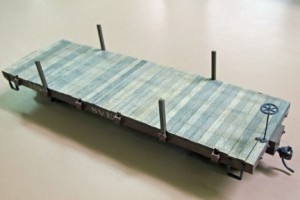
John White finished flat car with stained deck
Part 4 concerned a method of loading the flat car using what John calls a “load retention device.” This is platform that will hold the loads which is built to exactly fit between the vertical stakes of the car. This allows a quick switching of loads either during or between operation sessions to reflect the load/unload at industries on the layout.
John Mann was next up with a discussion of the numerous options for airbrushing. He pointedly indicated that he was only talking about airbrushing tools, not techniques. Airbrushing requires three items: an airbrush, a source of air and paint. First, he showed a $15 airbrush kit from Harbor Freight, definitely on the low price end of things. Next was a $500 Badger airbrush on the high end. John suggested that a good middle ground would be the $50 (approximately) Badger 350 kit which is gravity fed and being popular, all the needed accessories are readily available. He suggested that one always get a dust/moisture filter for the air line. Whether you want a single action or dual, gravity fed or syphon fed, most any combination is available from the major brands.

John Mann showing how to store paints for long term usability
John was very insistent that one practice, practice, practice before tackling a “real” model. A cheap practice medium could even be watercolors or diluted latex paints.
The next need is air and John indicated several sources: the cans of air sold for airbrushing, a compressor (with a tank), or even a spare tire – really. With any source, a good air gauge is a necessity. He finished up by reminding everyone that a clean work area — including a painting booth or other source to evacuate the fumes — clean paint, clean airbrush and clean air source are the keys to great results.
Our third clinic was by Tom Hawkins, our resident layout design guru. His talk was titled “Lessons I Have Learned.” Tom is currently designing a 15’ X 15’ layout for another member of the clinic and was the third place winner in a national design contest by Model Railroader.
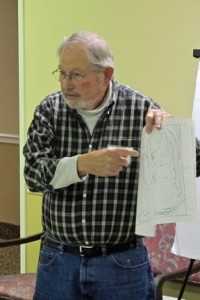
Tom Hawkins explaining plan details
Some of his lessons learned:
– no plan gets built exactly as drawn.
– always, always make sure you have access to hidden areas.
– if the layout isn’t reachable, make sure pop-ups included.
– double ended yard tracks can take more space than stub end tracks.
– yards need to be large enough to handle all the arrivals, departures and sorting that your operations scheme might require.
– it is amazing how much just a couple of inches in width of benchwork can make, adding a track or two extra in a yard or industrial area.
– avoid S-curves that are as short as your longest car, use #6 or greater turnouts to create crossovers.
– aisles need to be as wide as possible but it is always a compromise.
– try to keep minimum radii as large as possible and don’t forget the easements into curves.
After Tom, the clinic meeting was adjured to November 12th at which time Jack Hamilton and Di Voss are scheduled to present Nick Muff with his official MMR plaque and certificate prior to our regular clinic presentation.
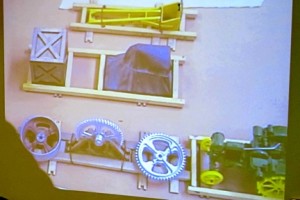
Assortment of John White flat car loads

